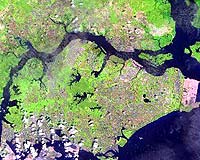 |
Hampton VA (SPX) Jun 08, 2009 Rising surface ozone concentrations are damaging nearly $2 billion in annual U.S. soybean crops, a NASA study of satellite measurements indicates. The study, headed by NASA Langley Research Center in Hampton, Va., was presented at the American Geophysical Union Joint Assembly meeting, May 24 in Toronto and looked at five years of soybean yields, surface ozone and satellite measurements of troposphere ozone levels in three Midwest states. Indiana, Illinois and Iowa are three of the biggest soybean producers in the U.S. and had peak crop damage in the hundreds of millions - part of more than $2 billion nationwide. "In the 19th and early 20th century, background surface ozone concentrations were relatively low so that an increase of 25 percent, (5 to 10 parts per billion), didn't affect living organisms," said Jack Fishman, a research scientist at NASA Langley's Science Directorate. "But now, we've crossed the line where you can expect to see modest increases in surface ozone result in crop growth being stunted." Ozone can protect or harm life on Earth. Six miles above the surface, ozone in the stratosphere is a shield from the sun's harmful ultraviolet radiation. In the troposphere or the closest layer (surface to 6 miles) ground-level ozone is a pollutant made from reactions between sunlight and human-induced emissions - harmful to breathe and damaging to plants. The severe heat of the Midwest each summer has combined with manmade emissions to create smog and increasingly higher levels of its primary component, surface ozone, over the past several decades. Fishman, former NASA Langley employee Jack Creilson and other researchers used soybean crop yield data during a 5-year period over the Midwest and analyzed the results using multiple computer models. The results are consistent with conventional ground-based measurements and with data obtained from an open-air experimental facility SoyFACE (Soybean Free Air Concentration Enrichment) at the University of Illinois at Urbana-Champaign. Their analysis suggests that the cost to the farmers globally is substantial, and supports other studies that calculate an economic loss of more than 10 billion dollars annually. Until now, the question of ozone impact on crop yield was mostly addressed by closed, chamber studies and on a larger scale at open-air facilities like SoyFACE. The study proved that space-borne satellite measurements of troposphere ozone - derived from NASA's Total Ozone Mapping Spectrometer (TOMS) prior to 2005, and from the Ozone Monitoring Instrument (OMI) since 2005 - are useful indicators of surface ozone concentration over a far broader area than ground-based monitors. The study used both satellite and surface observations of ozone, historic yield data and a sophisticated statistical model that also included factors such as ozone, temperature and soil moisture. Creilson, now at the Climate System Research Center at the University of Massachusetts, said the advantage of the satellite-derived method is that it can be used worldwide. Poorer countries have little monitoring capability and even in the U.S., croplands are so vast that a land-based network of ozone sensors would be extremely expensive to construct and maintain. "You have these farming locations that have no way of measuring surface ozone," Creilson said. "What we had to do was come up with a way of showing them there's a benefit of having the information." Share This Article With Planet Earth
Related Links Langley Research Center Farming Today - Suppliers and Technology
 Sky's the limit for Singapore gardens
Sky's the limit for Singapore gardensSingapore (AFP) June 5, 2009 When Albert Quek first moved into his home on the top floor of an eight-storey apartment block, he agonised about the limited space he had to pursue his passion for gardening. All he had was a one-square-metre (10.8-square-foot) balcony, barely large enough for his wife to sun the laundry, let alone for him to nurture a garden. Then he had a brainwave. "Why don't I do something verti ... read more |
|
| The content herein, unless otherwise known to be public domain, are Copyright 1995-2009 - SpaceDaily. AFP and UPI Wire Stories are copyright Agence France-Presse and United Press International. ESA Portal Reports are copyright European Space Agency. All NASA sourced material is public domain. Additional copyrights may apply in whole or part to other bona fide parties. Advertising does not imply endorsement,agreement or approval of any opinions, statements or information provided by SpaceDaily on any Web page published or hosted by SpaceDaily. Privacy Statement |